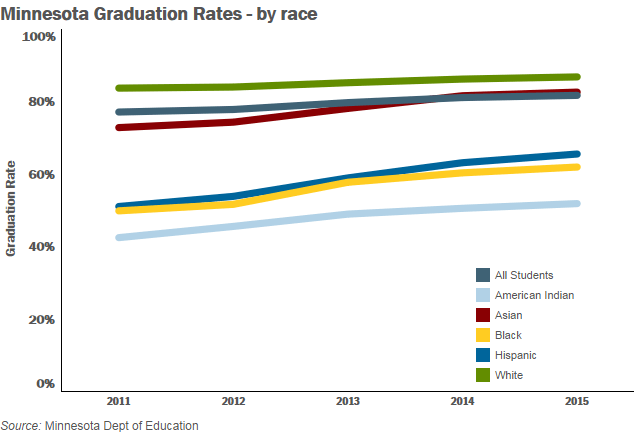MN graduation rates show small, uneven increase

Go Deeper.
Create an account or log in to save stories.
Like this?
Thanks for liking this story! We have added it to a list of your favorite stories.
Updated: 6:13 p.m. | Posted: 10:15 p.m.
Minnesota announced slight gains in high school on-time graduation rates Monday. But the progress isn't fast enough to meet the state's goals for closing the gaps between white students and students of color.
Statewide, the graduation rate inched up from 2014 to 2015 by less than 1 percentage point, to 81.9 percent. Minnesota has an overall goal of a 90 percent graduation rate by 2020. At this year's rate, that would take 11 years to achieve.
Turn Up Your Support
MPR News helps you turn down the noise and build shared understanding. Turn up your support for this public resource and keep trusted journalism accessible to all.
The biggest year-over-year gain Minnesota has seen since 2010 was just under 2 percentage points. The state would have to post that kind of progress consistently for five straight years to hit the 90 percent goal.
But Education Commissioner Brenda Cassellius is confident.
"I absolutely think it's possible," she said.
Cassellius said her optimism is based on a changed financial picture for education funding, with more resources now available to the students who will make up the class of 2020. By contrast, the class of 2015 suffered, she said.
"Most of those students spent most of their school years with budget cuts," she said. "With higher class sizes, with over-testing. Now we have the opportunity to fix that."

Cassellius said more school funding will let districts invest in counselors and other support staff to keep students on track. But the state generally doesn't dictate how districts spend their money.
National graduation figures won't be out for months, but for several years Minnesota's students of color have been graduating at lower rates than in most other states, and this year's progress is unlikely to do much to change that.
The achievement gap in the state has narrowed 14 points over the past five years, but this year it barely budged. Sixty-two percent of black students graduated in four years, compared to 87 percent of white students. For American Indian students, the rate was just 52 percent.

Minneapolis Public Schools have a bigger-than-average achievement gap. Interim Superintendent Michael Goar said the district is trying to intervene earlier with struggling students and provide more opportunities for them to catch up. But in-school strategies can only be part of the solution, he said.
"We have a high degree of homeless students, and there is a broader community issue we need to work on in terms of stability of housing," he said.
The Minneapolis district also includes eight alternative schools, for students who struggle in regular classrooms. The alternative schools can pull students from other districts, and Goar said the graduation rate there was just 18 percent in 2014.
Across the river in St. Paul, the achievement gap is closing, although graduation rates overall dipped slightly this year. Black and Hispanic students were the only groups at St. Paul Public Schools to see their graduation rates rise. Assistant Superintendent Theresa Battle credits racial equity training the district started in 2010. The training aims to alert teachers and administrators to racial biases that could affect how they treat students.
"If you look at the schools that had the largest increases, they have strong equity teams," she said.
To raise its overall rate, St. Paul will stick with current strategies including a program that helps middle-of-the-road students take advanced courses, Battle said.
Outside the metro area, some suburbs recorded falling graduation rates. Bloomington Public Schools saw a 10- percentage-point drop this year. Richfield, Brooklyn Center and Stillwater all had smaller decreases. Anoka-Hennepin, the state's largest district, saw its overall rate improve 4 percentage points.


